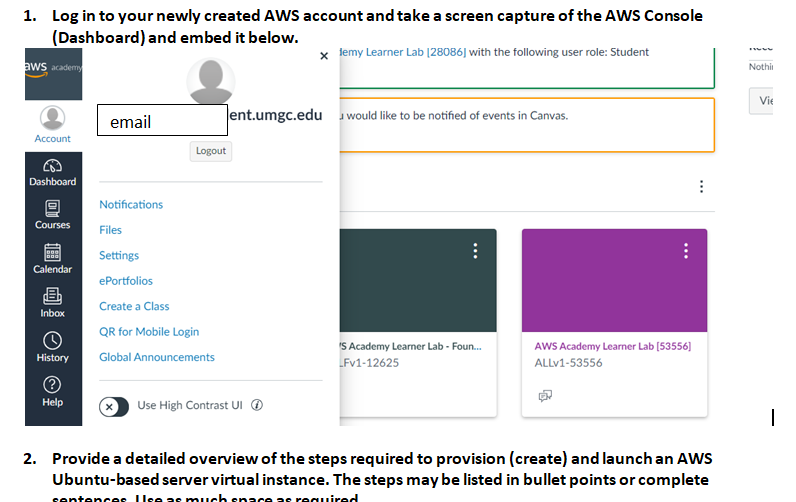|
For this assignment, the Caduceus CTO, Eliza, has asked you to create a working proof of concept. Step 1: Set Up and Log Into Your AWS Academy Account CMIT 495 requires you to complete hands-on assignments in a virtual environment. We will be using Amazon Web Services (AWS) as our virtual environment. Amazon offers a free account for those that register. UMGC will automatically add you to an AWS Academy Learner Lab. However, you still need to set up and log into your AWS Academy account to get started. Review the following AWS Academy (Student Guide) to set up and log into your AWS Academy Account, then access and use your Learner Lab. Be sure to read the guide carefully before proceeding: Note: The AWS Academy Learner Lab (Student Guide) provides students with instructions for using AWS Academy Learner Labs. The Learner Lab offers a lab environment suitable for student projects over a period designated by the department. Step 2: Download the Week 1 Project Template Download the template you will use to submit your project. (Virtualization Assignment Template.docx) Step 3: Install and Configure an AWS EC2 Instance (Virtual Machine) Using the newly created AWS free account, install and configure an Ubuntu Server virtual machine (VM) using the most recent version of the 64-bit operating system. You will need to provide a detailed overview of the steps required to install the Ubuntu server operating system on the virtual machine, including screenshots of each step in the process in the Week 1 Assignment Template. Review the following documentation detailing an overview and step-by-step procedure on how to install and configure an AWS EC2 instance. Step 4: Complete the Week 1 Project and Upload to the Assignment Folder Answer the questions and embed the appropriate screenshots of your Ubuntu server installation. When providing a detailed overview of the steps required to install the Ubuntu server operating system on the virtual machine, make sure to include screenshots of each step in the process. Further details and instructions are included within the Week 1 Assignment Template.
When complete, export your file as a PDF and upload it to the LEO Assignments folder (e.g., Project 1 – Virtualization Assignment).
|
|||
Rubric Name: Project 1: Virtualization Assignment
| Evaluation Criteria |
Exceeds
|
Meets
|
Approaches
|
Does not Meet
|
Criterion Score
|
|---|---|---|---|---|---|
|
1.1.3: Present ideas in a clear, logical order appropriate to the task.
|
8 points
Presents a logical flow of ideas that is easily identifiable and completely appropriate to the task. |
6.8 points
Presents ideas in a clear, logical order appropriate to the task. |
6 points
Attempts to present ideas, but the logic is not clear and/or not appropriate to the task. |
0 points
Does not present ideas in a clear, logical order appropriate to the task. |
Score of 1.1.3: Present ideas in a clear, logical order appropriate to the task.,
/ 8 |
|
1.4.1: Produce grammatically correct material in standard academic English that supports the communication.
|
8 points
Produces grammatically correct material in flawless standard academic English that fully supports the communication. |
6.8 points
Produces grammatically correct material in standard academic English that supports the communication. |
6 points
Attempts to produce grammatically correct material in standard academic English, but mistakes in some areas affect the credibility of the communication. |
0 points
Does not produce grammatically correct material, and the mistakes hamper the communication. |
Score of 1.4.1: Produce grammatically correct material in standard academic English that supports the communication.,
/ 8 |
|
2.3.1: State conclusions or solutions clearly and precisely.
|
8 points
States well-conceived conclusions or solutions clearly and precisely. |
6.8 points
States conclusions or solutions clearly and precisely. |
6 points
Attempts to state conclusions or solutions, but they are not clear or precise. |
0 points
Does not state conclusions or solutions. |
Score of 2.3.1: State conclusions or solutions clearly and precisely.,
/ 8 |
|
11.1.3: Install software.
|
19 points
Installs software that is fully functional and appropriate for the given requirements. |
16.15 points
Installs software that is appropriate for the given requirements. |
14.25 points
Installs software that may not be fully functional and/or appropriate for the given requirements. |
0 points
Does not state conclusions or solutions. |
Score of 11.1.3: Install software.,
/ 19 |
|
11.2.1: Configure technology according to stakeholder specifications and requirements.
|
19 points
Configures technology accurately and thoroughly to meet stakeholder specifications and requirements. |
16.15 points
Configures technology that meets stakeholder specifications and requirements. |
14.25 points
Attempts to configure technology according to stakeholder specifications and requirements. |
0 points
Does not configure technology that meets stakeholder specifications and requirements. |
Score of 11.2.1: Configure technology according to stakeholder specifications and requirements.,
/ 19 |
|
11.3.1: Add and update systems as required.
|
19 points
Exceeds all requirements to add and update IT systems. |
16.15 points
Meets all requirements to add and update IT systems. |
14.25 points
Meets some but not all requirements to add and update IT systems. |
0 points
Does not meet requirements to add and update IT systems. |
Score of 11.3.1: Add and update systems as required.,
/ 19 |
|
13.2.1: Evaluate vendor recommendations in the context of organization requirements.
|
19 points
Evaluate and provides detailed justification for vendor recommendations in the context of organization requirements. |
16.15 points
Evaluates vendor recommendations in the context of organization requirements. |
14.25 points
Attempts to evaluate vendor recommendations in the context of organization requirements, but some recommendations lack detail or do not consider context. |
0 points
Does not evaluate vendor recommendations in the context of organization requirements. |
Score of 13.2.1: Evaluate vendor recommendations in the context of organization requirements.,
/ 19 |
/ 100
Overall Score
Exceeds
Meets
Approaches
Does not Meet
Answer Preview: CMIT 495: Project 1: Virtualization Assignment


